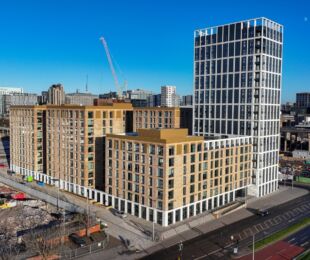
The brief for The Pulman redevelopment encompassed two existing buildings, 20-27 Thayer Street and 45-57 Marylebone Lane, and called for the integration of new offices and retail units into the historically rich environment of Marylebone, situated within the Harley Street Conservation Area.
The building plots that made up the site, owned by the Howard de Walden Estate, were joined and extended to form one building between the two streets. The façade fronting onto Marylebone Lane is designated as being of Historic Merit, and as such, was retained. The remainder of the buildings were demolished to make way for new, efficient office and retail accommodation. The architectural intervention demanded meticulous planning with Westminster City Council to ensure the design of the facades on either side of the building were kept in scale, to maintain the proportions of the existing townscape and reinforced the predominantly brick-faced street pattern.
York Handmade Bricks were specified for the project, which are made of clay from the Vale of York, although originally they would have been made along the Thames Estuary and thrown by hand. By incorporating various brick sizes and specials, Chapman Architects were able to design two unique facades that met the needs of the Conservation Area and were sympathetic to the site’s immediate context.
Thayer Street
This side posed the challenge
of designing a new-build brick façade that would concurrently relate to two
different building typologies on the street; the Grade II Listed Hind Street
Methodist Church on one side, and the high street residential buildings on the
other. In response, the new façade was segmented by an array of pillars with
slender fenestration in between, mirroring the rhythm of the neo-classical
stone façade of the church. The overall façade is organized in four separate
bays to resonate with the proportions of the high street buildings.
An elongated “Maxima” brick size, angular brick-specials and slips, were used
to form subtle tapered geometry to the façade, giving it a distinct character.
The brickwork was also taken into the interior and became a feature of the
reception area.
Marylebone Lane
To keep the character of the
meandering street, the Marylebone Lane elevation has been preserved and is
predominantly a 3-storey retained façade, but with two new storeys added above
the existing. The new-build fourth storey is broken by four gables, a familiar
construction in the area, to align with the four bays of the retained façade.
A metric sized blend of brick was used to match the brick of the retained
fabric, with pyramidal shapes to accentuate junctions of the new roof geometry.
Corbelled brick-specials gave depth to the new gabled profile, in a nod to the
retained deep cornice and dentils below.
It is a rich tradition that brick continues to be the material that helps bridge the divide between the traditional and the contemporary, as well as giving buildings a unique individuality.






